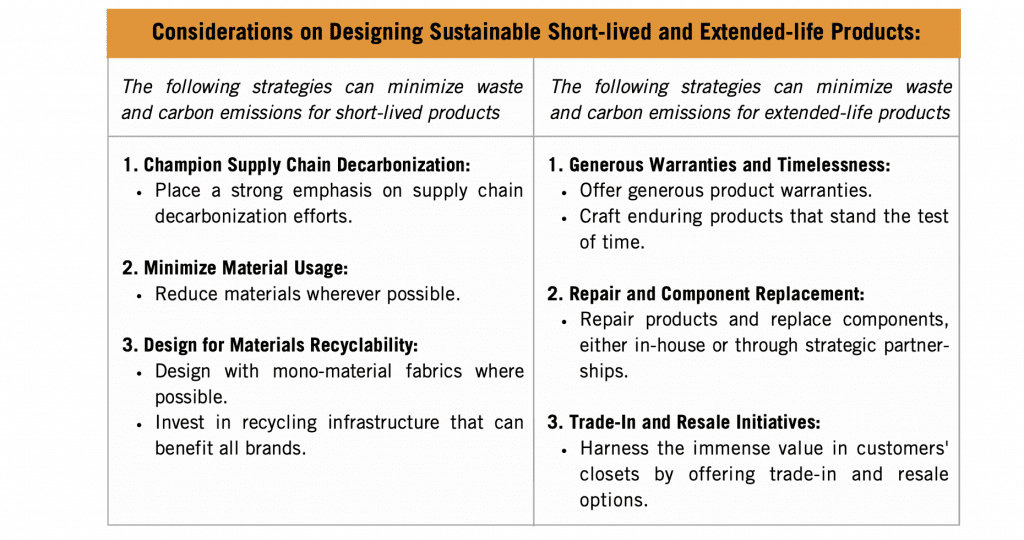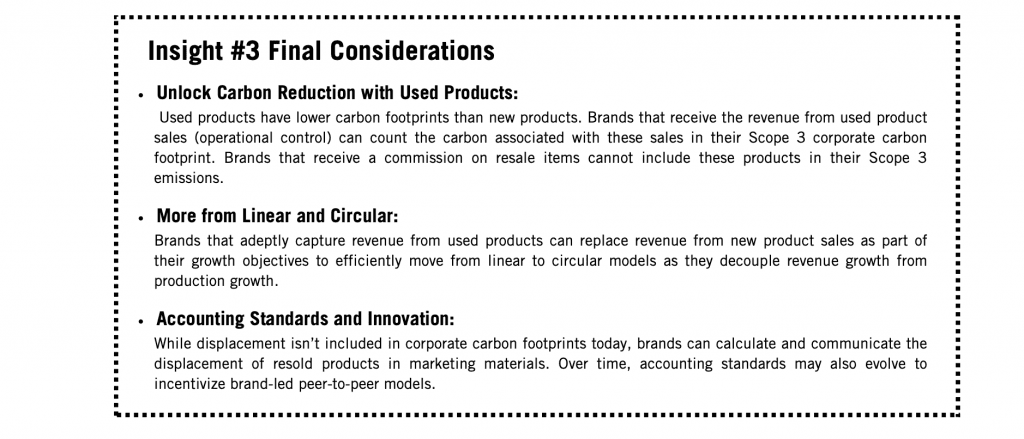Two new studies this week shed light on resale and RFID in retail, respectively, as sustainability and technology continue to be among the hottest topics in the industry – aside, of course, from AI. In the first study, resale company Trove and impact intelligence platform Worldly took on the topic of brands can utilize circular models as a way to help reduce their emissions, particularly when combined with upstream supply chain interventions.
At a high level, Trove and Wordly’s study, “Where Are Circular Models Effective Sustainability Strategies for Fashion Brands?”, centers on three key insights …
(1) Resale is a meaningful decarbonization strategy for Premium Apparel and Outdoor Brands: “Resale can result in a 15-16 percent reduction in annual carbon emissions in 2040, particularly for premium apparel and outdoor brands,” per Trove and Wordly. “Companies in these segments can achieve annual revenue growth and simultaneously reduce the need for new production by 23-35 percent annually.”
As distinct from premium apparel and outdoor brands, fast fashion companies and others with lower price points, “have faced challenges in the resale space,” Trove and Wordly assert, noting that “modeling shows that low-priced products don’t maintain value in resale markets and replacing new production and revenue with lower carbon resale products is less achievable in this space.” Not all is lost for fast fashion brands, however, as while “they may pursue resale strategies from a decarbonization perspective, their efforts are better spent on supply chain interventions and material innovation investments.”

(2) Brands maximize emissions benefits by increasing the value of their products in the resale market: Trove and Wordly conducted a scenario analysis to determine which model parameters impact brand decarbonization efforts most.

“Brands achieve the most substantial emissions reductions by amplifying the value of their products in the resale market,” the report states, with “product durability, design, and craftsmanship” playing pivotal roles. “The importance of demand, durability, timeless style, and low rejection rates (percent of items not eligible for resale) underscores the significance of product durability, design, and craftsmanship,” according to Trove. Whereas “resale program parameters, such as resale packaging, shipping, and trade-in incentives (e.g. gift cards), have less impact on carbon emissions.” Against this background, Trove and Worldly state that in addition to growing their resale channel in general, “brands that optimize key parameters such as resale price and sell- through will see the greatest emissions benefit.”
(3) Brands can maximize resale GHG accounting by maximizing operational control and used product revenue: Finally, there are two ways that resale lowers the carbon emissions of a brand: “By controlling operations, brands can include lower carbon resale products alongside new products as part of Scope 3, which reduces the average carbon per item and overall emissions; and by maximizing resale revenue increases the role of resale in achieving brand growth targets, which reduces emissions from production.”
In addition to being able to exert greater control over the conditions in which their pre-owned products are sold (which we dive into here), Trove and Wordly assert that “brands that control their resale operations and maximize revenue from used products are able to capture the greatest share of Scope 3 emissions benefit.” This is because under the Greenhouse Gas Protocol, “products sold by a brand (managed resale) can be included as part of Scope 3 emissions,” which is distinct from “products not under the brand’s operational control (peer-to-peer) [that] should not be included in Scope 3 calculations.” In short: “Brands that maintain operational control in managed resale have a direct means to capture the Scope 3 emissions reductions, as used items inherently have lower carbon footprints than new items.”

In a separate but similarly noteworthy report: Insight Partners has put a $701 million value on the market for Radio Frequency Identification (“RFID”)-based retail solutions. That market is expected to rise to $1.15 billion in value by 2030 thanks, in part, to the “ease of fabrication, miniaturized dimensions, low costs, endurance for extreme environments, effective read ranges, and beyond-line-of-sight communications” associated with new RFID tech.
In light of enduring shrink-related retail issues (i.e., inventory lost to theft or other factors), tracking and identification applications of RFID are useful for retailers, per Insight Partners, along with the “growing adoption of radio-frequency retail security tag systems as they can detect a device from several feet away, allowing the user plenty of time to deal with any potential shoplifting incidents.
The adoption of RFID-based retail security solutions is “driving the market for the segment,” according to Insight Partners, which is a nod to the continued advantages that RFID tech can bring in terms of logistics and inventory location tracking. Nonetheless, there are other, more-consumer-facing elements of RFID that are proving to be particularly attractive for luxury brands that are looking to add practical and/or story-telling-centric benefits to their offerings. Smart tags created by Beontag-owned company Temera, for example, have been deployed by brands like Alexander McQueen, Dolce & Gabbana, and Bulgari as a way to enable customers to access post-sale services and experiences via their smart phones. (Beontag raised €120M in January in a round led by Deutsche Bank in what it called a demonstration of the confidence in the market growth for digital RFID and NFC solutions.)
And in terms of the use of RFID for authentication … One of the most notable recent developments comes by way of the European Union, which announced the launch of its European Logistics Services Authentication initiative for products within the global supply chain this summer.
In short: The EBSI-ELSA initiative combines the European Blockchain Services Infrastructure with the concept of digital twins to provide individual products or shipment of products with a machine-readable label that takes the form of a QR code, RFID or NFC tag with the aim of ensuring product authenticity by promoting information sharing among the participants in the supply chain within a secure environment.
By the end of this year, EBSI-ELSA is expected to be an open-source platform to authenticate products and exchange data between all the parties in the supply and logistics chain, interconnecting products’ ‘track and trace’ solutions with the risk analysis systems of enforcement authorities and the EUIPO tools (TMview, DesignView, IPEP and IP Register in Blockchain). And by 2024, the EUIPO says that the objective is to synchronize IP authenticity management between all the parties involved in a supply chain: EU intellectual property offices, governments, customs authorities, manufacturers, transport and logistics operators, intermediaries, and retailers.